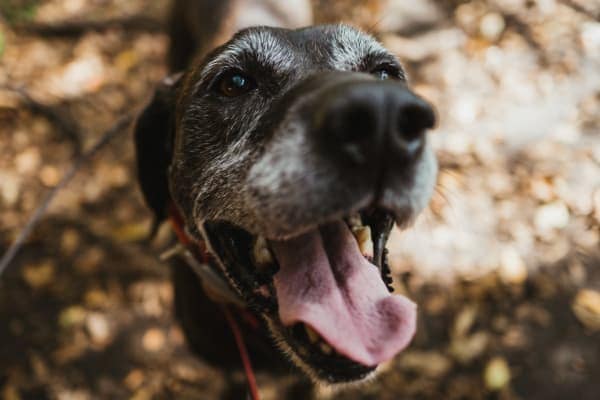When is a dog considered a senior? Integrative veterinarian Dr. Julie Buzby offers insight on when you can confidently welcome your dog into the prestigious “silver senior dog” club. Plus, get highlights on some common health issues you might encounter on the journey through your dog’s golden years.

When I’m in an exam room with a client and a senior dog, I love to hear their stories—from a first day home together to the purpose of the visit that day. Inevitably, I’m reminded that the bond between a loyal dog parent and his or her grey-muzzled companion is unconditional, unbreakable, and always one-of-a-kind.
It’s true—your dog is a pal and a confidant. And your heart’s desire is to see your dog thrive in every season of life. You’ve made that happen so far, and the golden years needn’t be different. But how do you know when you’re entering your dog’s senior years?
When is a dog considered a senior?
Well, it turns out, the answer to this question isn’t as simple as saying that one dog year equals seven human years. Instead, veterinarians use a combination of approaches to classify dogs as seniors. They are:
- Size correlation with aging—If using size to estimate senior dog status, you can estimate that
- giant breed dogs (those over 90 pounds) are seniors at 5 years old
- large breed dogs (51-90 pounds) become seniors at 5-8 years old
- small breed dogs (under 20 pounds) and medium-sized dogs (21-50 pounds) reach their senior years between 7 and 10 years of age
- Epigenetics—Researchers developed a formula for calculating your dog’s age in human years that takes into account changes in a dog’s gene expression during the aging process.
- Average life span for a breed—Since a dog’s senior years are roughly the final quarter of the life span, you can use the reported average life span for the breed or breeds of your dog to calculate at what age the dog enters the final 25% of his or her expected life span.
- Physical changes—Your vet may also classify your dog as a senior based on seeing signs your dog is aging such as a greying muzzle, a decrease in mobility, loss of sight or vision, and/or onset of signs of cognitive decline.
We will take a look at each of those approaches in more detail. But first, let’s talk about the question that probably weighs heavily on your mind—why can’t dogs live longer?
Why do dogs age so fast?
I think we can all agree that it seems like our dogs’ lives are over far too quickly. But as of now, the verdict is out as to why that is. Environment and genetics do play a role in aging, but there is a lot we still don’t know.
The Dog Aging Project, a collaborative research initiative, is currently following dogs through their lives to learn more about aging. There are over 50,000 dogs enrolled so far, and they continue to welcome more dogs to the study. The data from the Dog Aging Project will hopefully help shed light on how dogs age and the factors that influence aging. This information can then be used to help dogs (and people) live longer and stay healthier.
Now on to the details of why it isn’t so easy to figure out when a dog is a senior.
1 human year equals 7 dog years is a myth
When I was growing up, people thought one year of a dog’s life equaled seven years in a human’s life. It was simple arithmetic dog owners calculated at every doggie birthday.
Today, we know this “one dog year = seven human years” is inaccurate. It assumes that dogs age at a constant rate, which they don’t. Instead, they age more quickly during approximately the first two years of life and then aging slows down.
Plus, most dogs reach maturity by the time they are one year of age. That would be the equivalent of a human reaching maturity at seven years of age. Using this outdated formula simply doesn’t work to calculate your furry friend’s age.

The truth is there is no clear and simple way to determine an age at which all dogs would be considered seniors. However, dog breed and size certainly play an important role. That’s exactly what this next method of determining when your dog is a senior relies on.
Correlating size with when the dog becomes a senior
In a 2007 study from Texas A&M University, researchers looked at the effects of height and weight on the life expectancy of dogs. They found that shorter and lighter dogs lived longer than taller and heavier dogs. This suggests that small breed dogs age more slowly than large and giant breed dogs. Researchers think this might be the case because smaller dogs have less stress on their bodies, and especially their hearts, than larger dogs.
Based on knowing that the larger the dog is, the sooner he or she becomes a senior, you can use the table below to determine around when your dog hits senior status.
| Dog’s weight | Age when a senior |
|---|---|
| Up to 20 pounds | 7-10 years old |
| 21 to 50 pounds | 7-10 years old |
| 51-90 pounds | 5-8 years old |
| Over 90 pounds | 5 years old |
Using epigenetics to determine a dog’s age in human years
More recently, the University of California, San Diego published a study in November 2019. The study looked at Labrador Retrievers and how their aging compares to that of humans. By looking at epigenetics, or the way that the environment caused certain genes to be expressed or suppressed, researchers were able to develop a new formula for calculating a dog’s age.
The study determined puppyhood goes by as quickly as childhood in humans. But then aging slows down as a dog matures. The authors admit the study isn’t perfect since it only looked at Labrador Retrievers. But it is a great start.
Curious what this formula says about your dog’s age? Check out the formula for calculating a dog’s age in Smithsonian magazine.
Calculating when a dog is a senior based on the breed’s average life span
Both of the methods above can be useful, but they don’t take into account breed variations within a size category. For example, Beagles and French Bulldogs would both be expected to become seniors at 8-10 year of age according to the size-based chart. However, a 2010 study which included 15,881 dogs determined that the average life expectancy of a Beagle is 12.67 years. But it is only 9 years for a French Bulldog.

Since scientists generally consider the senior years to be the last quarter of a dog’s natural life span, a Frenchie and a Beagle would therefore not become seniors at the same time. If you do the math (9 year life span x 0.75), the French Bulldog would be a senior at 6.75 years old. But the Beagle wouldn’t be a senior until he or she was 9.5 years old (12.67 year life span x 0.75).
Thus, another way to determine when your dog is a senior is to look up the average life expectancy of his or her breed and then multiply it by 0.75. It is possible that this may give you a more accurate idea of when your dog becomes a senior than just weight alone would.
Looking for signs of aging to determine when your dog is a senior
Lastly, instead of just looking at a senior dog’s age, it is important to take a look at the dog too. Some dogs seem to age prematurely, especially if they have chronic health problems. Others are fit and spry well into what would traditionally be considered their senior years.
Signs of aging in dogs
When determining if your dog is a senior, it can be helpful to look for the following signs of aging in dogs:
- Grey around the muzzle and eyebrows—A dignified grey muzzle accompanies aging for some dogs.
- Loss of mobility—Your dog might start to have more trouble climbing stairs, jumping up onto the couch, or taking long walks due to arthritis.
- Weakness—As a senior dog loses muscle mass or suffers from orthopedic problems, he or she may become weaker.
- Lower exercise requirements—Instead of wanting to run for miles and still having energy to keep going, a senior dog may be content after a shorter walk or run.
- Decrease in vision or hearing—Cataracts in dogs or other conditions may threaten your dog’s eyesight. And your senior dog may experience some hearing loss in dogs.
- Signs of dementia in dogs—Getting lost in the house, senior dog anxiety at night, changes in personality, regression of housebreaking, or other behavior changes can occur as an older dog develops canine cognitive dysfunction.
- Poor quality coat or nails—Your dog’s hair may become dry or rough and his or or nails may become brittle.
- Dental disease in dogs—Dog bad breath, head shaking, or reluctance to eat may all point to dental problems.
- Weight loss—Sometimes you may notice your dog is losing weight but eating well. Other times he or she has a decreased appetite too.
- Weight gain—Senior dogs need less calories than adult dogs, so they may gain weight if you continue to feed them the same type and amount of food as when they were younger.
Based on seeing some of the changes above, you or your vet may decide to classify your dog as a senior.

7 health issues when your dog is considered a senior
Just like in humans, age increases your dog’s risk for various health issues. Next, let’s look at common health conditions to watch for and how you can help protect your senior dog’s health. Having an awareness of these health concerns may help you and your veterinarian diagnose and treat them earlier.
1. Watch for the signs of arthritis
Osteoarthritis in dogs is a progressive, irreversible degeneration of the cartilage and bone within a joint. As your dog ages, cartilage and other soft tissues that cushion the joints become less elastic and flexible. This is especially true for large dogs. Because of this, your dog may experience joint pain due to inflammation.
Your vet may prescribe an anti-inflammatory medication such as carprofen for dogs to help relieve arthritis pain in dogs. Also, joint supplements for dogs are a great way to proactively protect your dog’s joint health. Plus, there are lots of options for natural pain relief for dogs. Some of the more popular ones include acupuncture for dogs, underwater treadmill for dogs, PRP for dogs, PEMF for dogs, and laser therapy for dogs.
2. Be aware of kidney disease in dogs
Your dog’s kidneys filter toxins and waste products out of the blood. Over time, the filters (called nephrons) don’t work as well as they used to. When damaged nephrons begin to shut down, the active nephrons become overworked, and the body can’t eliminate waste products efficiently.
Older dogs who develop this form of kidney disease in dogs have what we call chronic kidney disease. Sometimes the vet can detect markers of kidney disease on blood tests for dogs before your dog is symptomatic. Other times, you may not know your dog has kidney disease until he or she starts showing symptoms such as increased thirst in dogs, increased urination, weight loss, vomiting, and a lack of appetite.
3. Periodically check your dog for lumps and bumps
Tumors, skin tags, lipomas in dogs, and other growths can happen at any age. But senior dogs are at increased risk. While most skin growths are benign, some, such as mast cell tumors in dogs, are malignant and can potentially spread to other parts of the body. Make sure to check your dog regularly for new lumps or bumps. And should you find one, bring it to the attention of your veterinarian right away.
4. Be on the lookout for signs of canine cognitive dysfunction
One of the most common signs of aging in dogs is behavior changes. Senior dogs who seem more anxious, disoriented, or have changes in their sleep-wake cycles may have a disorder known as canine cognitive dysfunction or CCD. If your dog has CCD, you may also notice that he or she has accidents in the house or paces, often in the evening or at night.
If you are worried your dog may have dementia, fill out a canine cognitive dysfunction checklist. Then make an appointment to talk with your vet. While there is no cure for CCD, there are some things you can do to help manage this condition. Senior dogs who are showing signs of CCD can benefit from supplements such as Dr. Buzby’s Brain Boost™ organic MCT oil for dogs, medications such as selegiline for dogs, or enrichment such as brain games and puzzle toys.

5. Protect your dog from the effects of dental disease
Dogs develop dental disease just like people. Without proper dental care, senior dogs can develop significant oral infections that contribute to mouth pain, bone loss, dog tooth root abscesses, older dog losing teeth, and even heart disease.
At-home dental care like dog toothbrushing and choosing safe chew toys for your dog can make a big difference in his or her oral health. Plus, to help prevent dental disease in dogs, establish routine vet dental check-ups at least yearly.
6. Be able to recognize the signs of heart disease in dogs
Older dogs may be more susceptible to developing heart disease in dogs. For example, older small breed dogs can develop mitral valve disease in dogs. This disorder of the heart valves causes blood to leak through the closed valves when the heart contracts. Affected dogs may develop congestive heart failure in dogs as the valvular regurgitation worsens.
Symptoms of heart disease include a dog breathing fast, the dog coughing and gagging, weakness, and exercise intolerance. Sometimes your vet may be able to detect early heart disease by finding a heart murmur in dogs or an arrythmia. However, not all heart conditions cause those changes. Thus, it is also important you monitor your dog carefully for any signs of heart disease and report them to your vet promptly. Early detection is vital because typically, the sooner you intervene the better.
7. Understand endocrine diseases in senior dogs
The endocrine system is a complex network of hormones that help control many processes in the body. However, sometimes the body makes the wrong amount of a hormone. This leads to endocrine disorders such as diabetes in dogs, hypothyroidism in dogs, and Cushing’s disease in dogs.
These conditions can cause dogs to gain weight, drink more water and urinate more, and act like they are hungry all the time. Middle-aged and senior dogs have a higher risk for developing these health problems, which is why it is important to have endocrine diseases on your radar as your dog gets older.
10 Tips for keeping your dog healthy during the senior years
Being proactive about watching for the diseases and conditions listed above is great. But if you want to go one step further in safeguarding your senior dog’s health, consider following these 10 tips.

#1: Provide mental stimulation for your aging dog
Research has indicated that exercise and enrichment for senior dogs can help boost brain health. Thus, incorporating mental stimulation toys and games for dogs into your routine can be both fun and beneficial.
#2: Focus on nutrition for your senior dog
It important to know how to feed your senior dog. Just like at any other point in your dog’s life, proper nutrition is vital for the health of senior dogs. There are a variety of foods targeted toward the general needs of senior dogs. Plus, prescription diets can be helpful for certain conditions such as liver disease, kidney disease, or canine cognitive dysfunction.
#3: Keep your senior dog at a healthy weight
Being overweight or obese puts extra strain on your dog’s joints and organs. This can worsen arthritis pain or predispose your dog to multiple health conditions. Thus, it is important to regularly determine your dog’s canine body condition score. Then talk to your vet about how to help your dog lose weight if necessary.
#4: Provide your aging dog with regular low-impact exercise
Staying active during the senior years is so important. By walking, swimming, or doing other sorts of exercise with your senior dog, you can help your dog maintain strength and muscle mass. As a result, he or she may be able to enjoy better mobility and less pain.
#5: Regularly perform a dog health scan
Routinely completing a 5-minute dog health scan can help you know what is normal for your dog and recognize problems quickly. To become a pro at the health scan, check out my online course, Dr. Buzby’s Tip-to-Tail Dog Health Scan™.
#6: Monitor your senior dog’s quality of life
Many parents of senior dogs find it helpful to fill out the dog quality of life scale on a monthly, weekly, or even daily basis. This helps them detect subtle changes in the dog’s quality of life. Plus, it provides an objective look at the dog’s status, which can be helpful when facing difficult decisions.
#7: Learn about senior dog supplements
There are a wide range of valuable senior dog supplements. Some of my favorites are omega-3 fatty acids for dogs, MCT oil for dogs, deer velvet for dogs, and green lipped mussel for dogs. Your vet can help you determine which ones are right for your dog.
#8: Bring your dog to the vet at least twice a year for a wellness exam and bloodwork
As dogs age, they are more likely to develop medical conditions. Visiting the vet for a checkup and screening blood tests twice a year can help detect problems sooner. And it also means your dog gets treatment sooner.
#9: Keep up with parasite preventatives
Senior dogs need heartworm medicine too. And they also need to be protected against fleas, ticks, and internal parasites.
#10: Partner with your vet
Building a strong relationship of trust and respect with your vet is always a good idea. But it becomes even more important as your dog enters the senior years. Your vet can help you navigate whatever challenges your dog may face.
What age is a dog considered a senior?

Bottom line: There is no one answer to the question, “How old is a senior dog?”
However, there are some good methods to use. You can determine your dog is a senior when he or she reaches the last 1/4 of his or her expected life span or when you start to see signs of aging. Or you can look at your dog’s size and remember that small and medium breeds are seniors at 7-10 years, large dogs at 6-8 years, and giant dogs at 5 years. Finally, you can use the epigenetics-based formula shared earlier to convert your dog’s age to human years.
Whatever method or methods you use, the important thing to remember is that by following the tips shared in this article and keeping a close eye on your sweet old dog, you can be a knowledgeable guide during his or her golden years.
Do you have a senior dog in your life?
Please let us know how you care for your senior dog. We can all learn from each other.


Need information on cats also everyone forgets about them or there are just not enough information on them.When are cats considered seniors and what diseases do they get when old and what vaccines do they need when older.We need information for indoor cats only.. Thanks
Hi Barbara,
I understand your need for information. Cats are important too! Unfortunately, there are just too many important topics to cover with a simple reply and this website is specifically designed to address the needs of senior dogs. Your vet should be able to address all of your concerns and answer your questions. Wishing you all the best and take care.